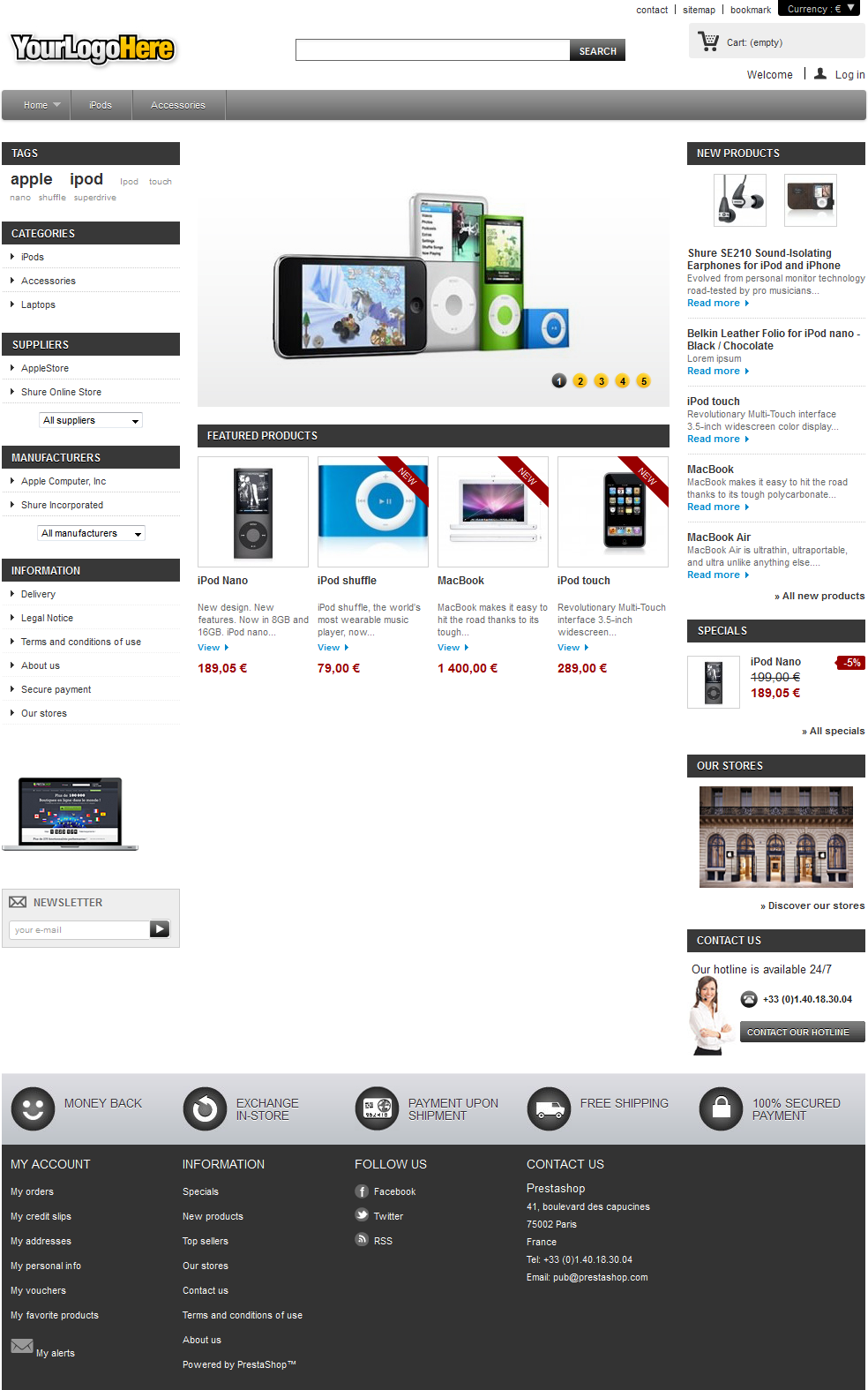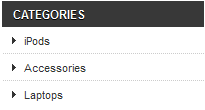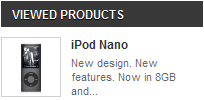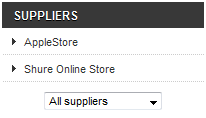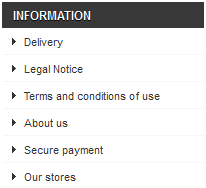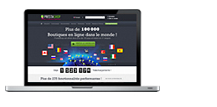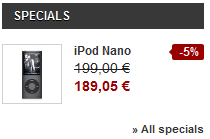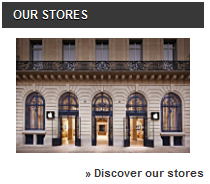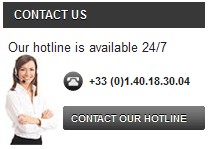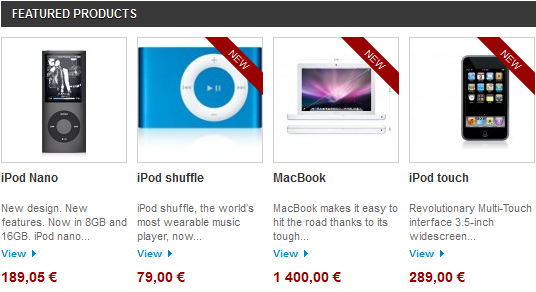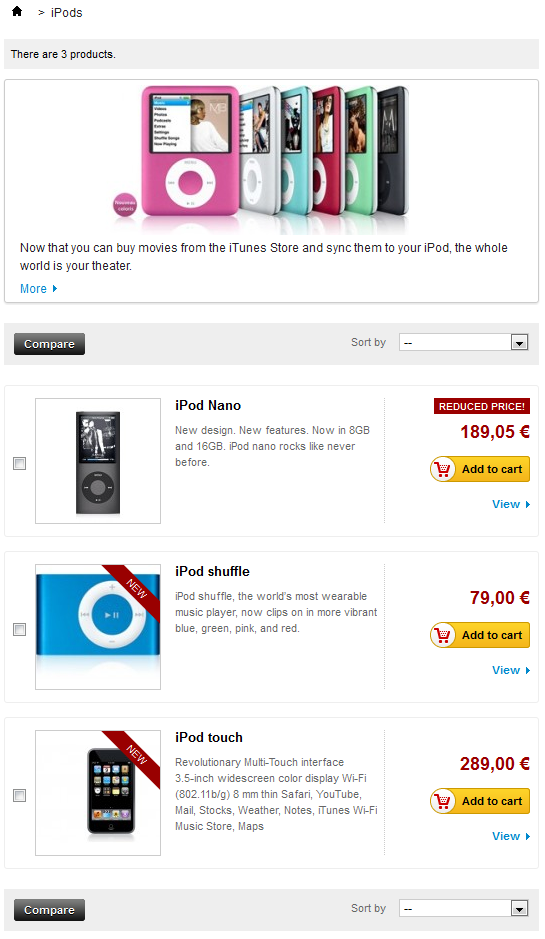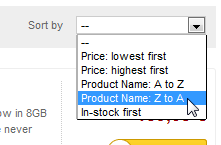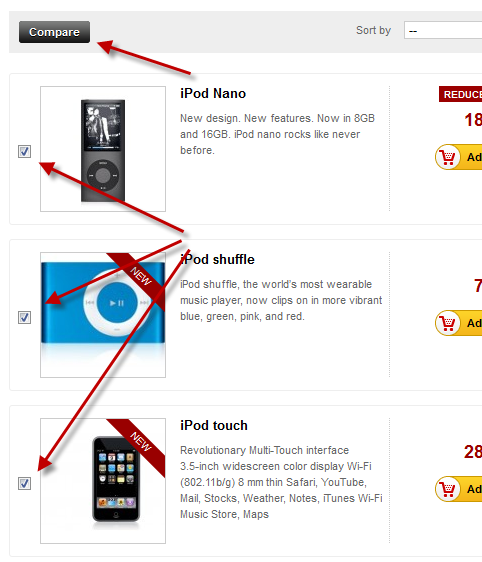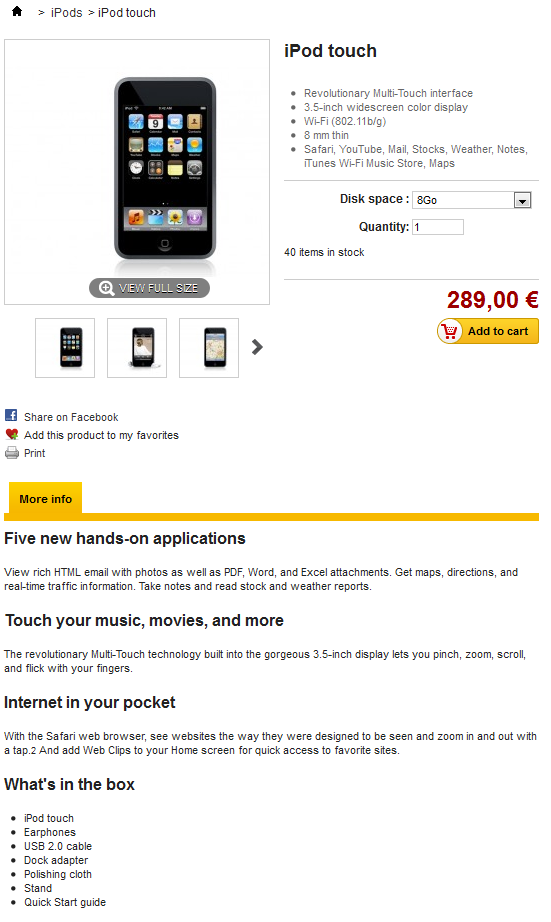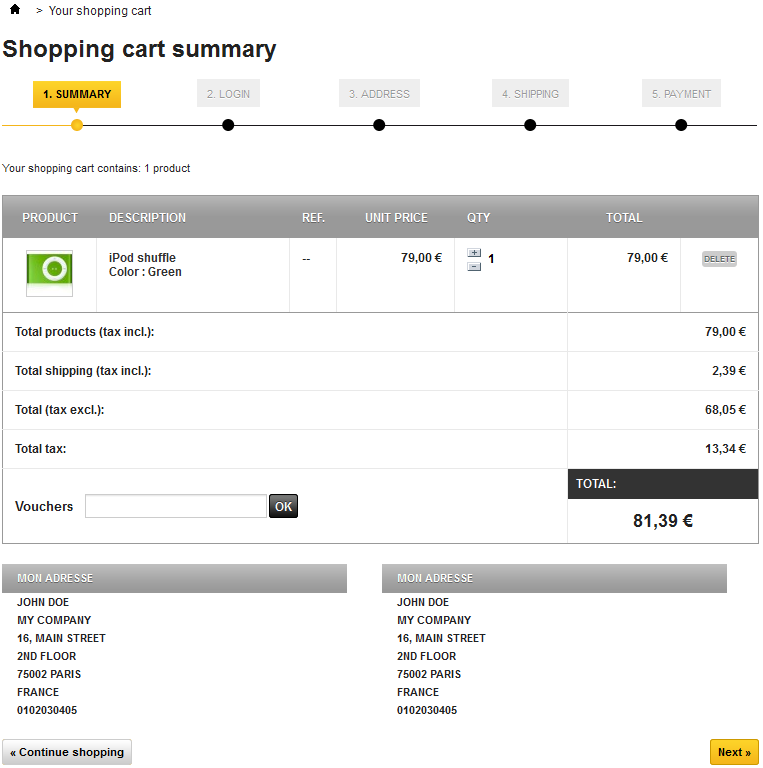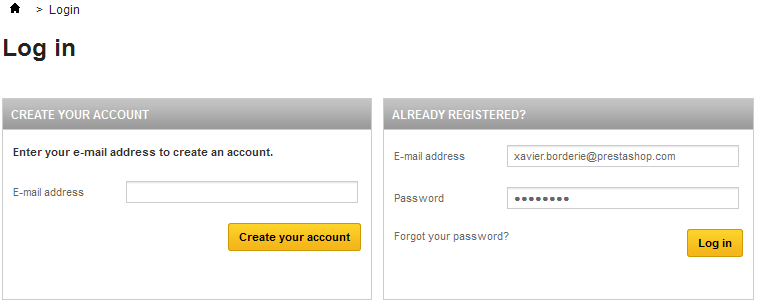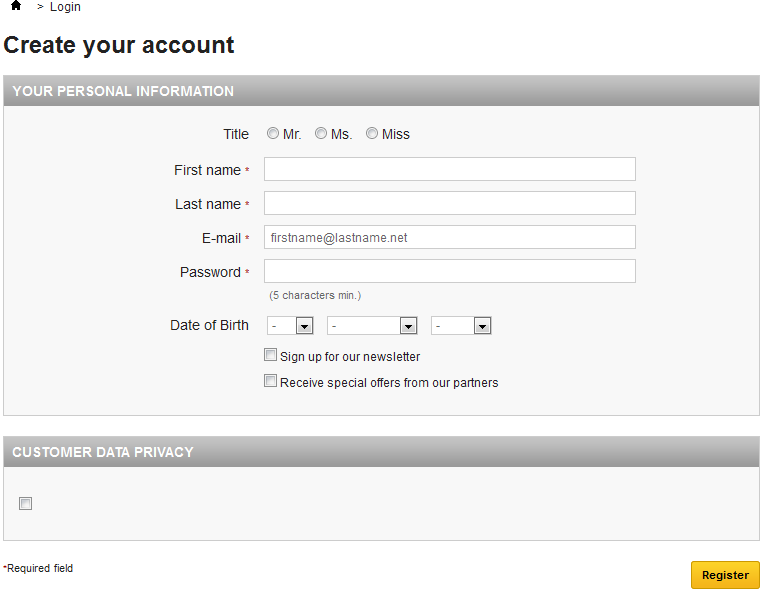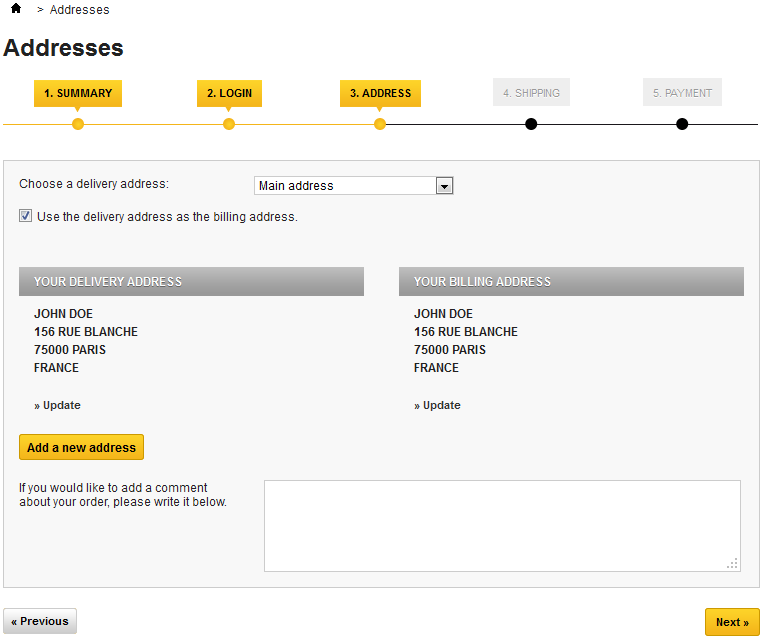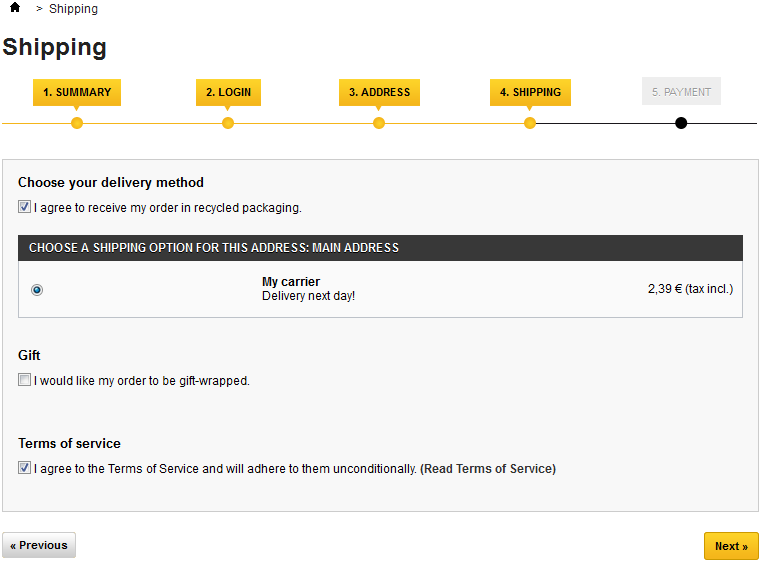| Warning |
|---|
This documentation is currently being worked on. Until the stable version of PrestaShop 1.5 is released, it should not be seen as definitive. |
| Section | ||||
|---|---|---|---|---|
|
Table of content
| Table of Contents |
|---|
...
| maxLevel | 2 |
|---|---|
| style | disc |
| printable | false |
Browsing the front-office
A shop's The front-office is what customers constantly see when browsing ityour shop. It 's is the interface, the products, the pictures, the descriptiondescriptions, the whole transaction purchase process, etc.
As a customer, this is all you 'll will see of a shop during your browsing and buying experience, from start to finish.
...
If you installed PrestaShop with its sample data, you will see Apple products.
While the shop owner can change the front-office theme at any time, thanks to the wealth of themes that are available on the PrestaShop Addons website (http://addons.prestashop.com/), we will base this chapter on the default theme only.
Note that we here are describing the default theme with its default settings and modules. Activating other modules, or obviously using another theme, can dramatically change the shopping experience.
...
The header is a thin bar of content, accessible from any of the front-office pages.
It contains several essential tools and links, which apply to the whole shop:
- The shop logo. A click on the logo brings the customer back to the front page, from anywhere in the shop. The default logo reads "YourLogoHere": this is an incentive for you to use your own logo rather than keeping the PrestaShop one (as was often the case with the previous default theme).
- The search engine. Many customers prefer to look for a specific item through the search engine rather than browsing through categories after categories of products. On some online shop, this is even the only way to browser the site's content for most customers.
- Contact and Sitemap. These two links take the customer to specific pages, out of the shopping context: contacting the shop administrators, or viewing a complete list of all the pages that are publicly accessible.
- Bookmark. This is not a link per se, but a JavaScript action: when clicked, it will trigger the customer browser to add the shop as a bookmark. The customer can then choose to complete the action or not.
- The currency selector. The customer can choose the currency in which the shop should display prices. This is great in order to compare prices with other international shops.
- Cart: (empty). A quick reminder of the current status of the customer's cart. Sometimes customers select items while browsing and forget about them after a few pages. It is therefore essential to give them a way to keep these products in mind.
- Welcome. A simple welcome message. When the customer is logged in, it becomes "Welcome Firstname", with the customer's first name being a link to his or her customer account.
- Log in. An invitation for the customer to connect to the shop by entering their credentials. his or her credentials, or to create an account. Once connected, the customers is taken to the "My account" page.
If connected, this will display "Welcome, (firstname)Log out". - "Your account". A link to the user's account, or if not connected, to the authentication/registration page.
The header hardly ever changes throughout the whole buying experienceThe header hardly ever changes throughout the whole buying experience.
The cart
The header's essential part is the cart. By default, it is folded in order to only show the number of products it currently contains. The customer can click on the text to access the shopping cart summary, from which the checkout process can be started.
The block's interface changes when the customer puts its mouse cursor over the cart: it opens to display exactly the name of each added product. Each product lines features the quantity, the combination (if any), and the price. The customer can also directly remove unwanted product with a click of the mouse.
The bottom of the block adds the shipping costs and the total price of the order, along with a "Check out" button leading to the shopping cart summary, from which the checkout process can be started.
The footer
The footer gives access to pages that could be useful to your users.
...
- The "My account" block, containing links to the main pages of the user's profile (or the authentication page):
- My orders. All past and currently processing orders.
- My credit slips. Received when an order has been canceled. Credit slips can be used for any future order.
- My addresses. A customer can add multiple addresses for different delivery options.
- My personal info. First name, last name, e-mail address, home address, phone number, date of birth: all the necessary information about a customer.
- My vouchers. All coupons code that have not yet been used.
- My favorite products. The
- customers can mark products as favorite, for later purchase. They are stored here.
- The "Information" block, containing:
- Three links to products lists:
- Specials: all . All the current promotions.
- New products: recently . Recently added items.
- Top sellers: most . Most popular items.
- Four links to informational pages:
- Our stores
- Contact us
- Terms and Conditions
- About us
- Three links to products lists:
- The "Follow Us" block, containing links to your shop's Facebook and Twitter accounts, and a link to your CMS's RSS feed.
- The "Contact Us" block, containing the address, phone number and e-mail address of the shopyour business.
Note that all this content can be changed by the shop owner.
...
The default theme's left column stays primarily static, as it mainly serves as a handy placeholder for navigation and secondary links:
- (if logged in) "My account" block, with links to the customer's account pages.
- Three of the default blocks help the user navigate the shop and filter content: tags, categories and manufacturers are the most common ways by which shoppers look for a given product.
- "Viewed products" serves as a reminder of the products previously took interest in, and gives a shortcut back to these if he wants to pick them in the end.
- Finally, "Information" is where PrestaShop lists the default static pages, as written by the shop owner: delivery information, legal notices, T&C... They are not selling points, but their content is important enough that it warrants being always available.
"My account" block
Once the customer is logged in, the "My account" block appears in the left column. Its sole purpose is to give the customer quick access to all his or her personal pages:
- My orders. All past and currently processing orders.
- My credit slips. Received when an order has been canceled, credit slips can be used for any future order.
- My addresses. A customer can add multiple addresses for different delivery options.
- My personal info. First name, last name, e-mail address, home address, phone number, date of birth: all the necessary information about a customer.
- My vouchers. All coupons code that have not yet been used.
This block is a replication of the content of the "My account" page, which can be accessed from the eponymous link at the right of the header.
Categories
.
Tags block
The shop owner can indicate a set of tags for each product. A tag is a non-hierarchical keyword, also described as metadata: it is not displayed on the product page as it does not bring any useful information, but it can prove very useful when building thematic lists – such as a tag-cloud, where the most common tags are written in a bigger font than the rarer ones.
Categories block
A category is a hierarchical way of sorting items: it can contain any number of sub-categories, making it possible to easily browse from the more general category listings to the more specific products by following a logical path.
...
This is also the only product list view where the customer can compare products by ticking their checkbox and selecting the "Compare" button.
Tags
The shop owner can indicate a set of tags for each product. A tag is a non-hierarchical keyword, also described as metadata: it is not displayed on the product page as it does not bring any useful information, but it can prove very useful when building thematic lists – such as a tag-cloud, where the most common tags are written in a bigger font than the rarer ones.
Manufacturers
"Viewed Products" block
Only displayed when the customer has viewed at least one product during the current session.
This block serves as a reminder of the products previously took interest in, and gives a shortcut back to these if he wants to pick them in the end.
Suppliers block
Customers can choose to display all the products from a single supplier, regardless of their types or prices.
Manufacturers block
Customers can choose to display all the products from a single manufacturer, regardless of their types or prices.
CMS block
This is where PrestaShop lists the default static pages, as created by the shop owner: delivery information, legal notices, T&C, etc. They are not selling points, but their content is important enough that it warrants being always available.
Advertising block
By default, this block features a simple image with a link to PrestaShop's official website. You can change the settings of this block to turn this into an ad for a friend's website or another shop.
Newsletter block
Customers can register to your shop's newsletter directly using this form. Afterwards, the newsletter itself is entirely managed by you; PrestaShop does not handle the transmission of e-mails to the customers.
The "Newsletter" module enables you to generate a .CSV file of all the registered customers and their e-mails, and you should be able to import that CSV file in any e-mailing system.
The right column
The default theme's right column hardly ever changes in the course of the shopping experience. Its main block is the "Cart," where the customer can glance over and see what currently in his cart and how much it will cost, and remove unwanted product with a click of the mouse. It also gives your customers quick access to
These blocks are always available, from any page, in the default theme.
New products block
This block presents the latest new products, with links to their respective pages.
Specials block
This block gives your customers a quick overview of the current promotions (if any) through the "Specials" block. Finally, customers can locate the closest store by clicking on the "Our stores" block.
These three blocks are always available, from any page, in the default theme.
...
, with the original price and the discount price.
"Our stores" block
This block contains an image-link to the Store Locator tool, which enables your customers to find the closest physical store. It is essential if your business if you have physical stores, and can be disabled easily if you do not have any.
"Contact us" block
Having your hotline phone number available from every page of your shop is essential.
The central section
This is where the magic happens. The middle central section changes constantly in response to the customer's choices.
...
The default front page gives the customer a broad overview of the shop and its possibilities. An image and a welcome text serve as slider serves as an introduction to the shop.
These are
The slider is followed by the "Featured products" block, presenting products that the shop owner chose to highlight, either for their novelty or their current price.
Most seasoned web surfers will visit a shop via a search engine, landing directly on a product or category. Few stumble upon the home page, and this is why it should be tailored to new users.
...
Categories, tags, manufacturers, suppliers, search, specials page, best sellers page or new products page: PrestaShop has many paths to a product, but in the end the customers is given a familiar listing of products, within the chosen context.
Despite the differing content, this listing designs are very similar, in order to keep it familiar even for the newcomers:
- Thumbnail Main thumbnail on the left.
- Name and description in the middle central section.
- Price, availability, "Add to cart" button and link to the product's page on the right.
This list view enables the customer to see at a glance the products' main information when they already know everything they need about a product, allowing for a quicker decision process.
A click on the "Add to Cart" triggers a quick animation, sending the product's thumbnail flying into the "Cart block" section.
Image mapping
...
Category header: image and image map
Categories can feature a header image , where at least two products are displayed, and with direct link to these products. One with an introductory message, as set by the shop owner.
While this is not the case by default, you can choose to have the category image replaced by an image map. A category can feature an unlimited number of image - maps, which you the visitor can scroll through with the tool below it.
An image map is simply an image which has links available for some of its areas. A "+" symbol is placed upon the products which are linked from that imageareas which have links. The image map can feature as many links as necessary: in the default demo shop content, the iPod Nanos image-map features 9 links.
Product sorting
Product listing by category or manufacturer can be further sorted by price, name or availability.
Note that listing by tags does not allow for such sorting.
Product comparison
Products within a category can be compared to each other, thanks to each item's "Select to compare" checkboxcheckbox (on the left of the thumbnail). This is the only way to compare productproduct listing where the customer can compare products, since there is no sense in comparing product products that do not have the same characteristics/features. Obviously, this means that categories should only feature products which can be compared.
Provided the product's information is complete and consistent, the comparison page will display with a row for each comparable feature. This is immensely useful, particularly for products with technical differences.
Customers By default, customers can compare up to 3 products at a time, but this can be changed in the "Products" preference page in the back-office.
Product
...
page
This is where all the information entered by the shop owner is available to the user. Depending on the theme design, a product page can be very thorough, with extensive information, or simply present the most essential facts. The default theme is typical in that its most prominent feature is the product images, with a scrolling tool below it enabling customers to scroll between the available images.
Next to the images are two blocks:
- A "Short description" block, presenting the main facts for the current product.
- The "Add to cart" block, with the option to choose among the available variations combinations (as defined by the shop owner) and the quantity to be ordered.
At the bottom of the product page are tabs, the two default ones beingis a tab section. The most usual ones are:
- More info. This is where the customer will find the gives the full description for the product, as entered by the shop owner.
- Data sheet. This is where PrestaShop lists tab only appears if the shop owner has entered data in the product's "Features" sheet. This gives all the detailed featured that were entered into database. This data is also the one that is used when comparing two products. Therefore, the content of this tab is very sparsely written: these are just raw facts, far from the product description in the "More info" tab.
The
...
cart page
Clicking on the "Cart" button from the "Cart" block in the right column: XX products" link in the header, or on the cart symbol "Check out" button in the cart interface also in the header, brings the customer to the "Shopping cart summary" page, which is the first step in the order process, as indicated by the . The breadcrumb trail at the top , indicating the next of the page indicates the steps in the order process:
- Summary. Where the customer makes sure that the order only contains the wanted products, no more, no less.
- Login. Where the non-logged customer is asked to log in or create an account. This step is skipped over if the customer is already logged in.
- Address. Where the customer is presented with his or her currently registered addresses in PrestaShop, and has to choose the one where the delivery is to be made.
- Shipping. Where the customer choose the shipping options.
- Payment. Where the customer is presented with the final price of the order (now including the shipping price), and is asked to choose a payment method.
The customer can come back to any previous step by clicking on its title.
| Note |
|---|
The standard order process takes 5 steps, and as many pages. You can choose to have all these steps on one page by going in the back-office, and in the "Orders" preference page, change the "Order process type" option from "Standard (5 steps)" to "One page check out". |
The cart page gives a succinct but complete view of the items that are in the cart: thumbnail, name, features, availability, unit price and ability to change the quantity of each product.
...
Clicking "Next" starts the check-out process.
Creating
...
a client account
Because it is one of the main sources of lost customers for online shops, PrestaShop makes it simple and straightforward to create a customer account.
When clicking the "Your account" or "Log in" linkslink in the header, the visitor is taken to the authentication page, where they have he or she has to fill one of two forms:
- Create a new account.
- Login Log in to an existing account.
The first step for a new customer to create his an account is to enter his or her e-mail address in the form and validate. This will bring him to up the account creation page itself. Two blocks of information are necessary to fill in order to get an account:
- Personal Your personal information. Everything that can uniquely identify the customer: first name, last name, e-mail (already entered), date of birth.
- Your address. This will be the default shipping address for this customer - he can have many more, but it's better to ask for one now rather than have him create one while confirming the order, and risk losing a sale.
Customer data privacy. When registering to PrestaShop, the visitor has to agree to your data privacy. It is up to you write it, as it will legally bind you and your customers' data.
Info You can change the content of the customer data privacy warning section by changing the configuration of the "Customer data privacy block" module (from the "Modules" page). Make sure to change it for all the available languages.
Once registered, the customer is redirected to the "My account" page, where he can already see what he has access tomany options can be accessed: order history, credit slips, vouchers, and access to the previously entered information.
| Note |
|---|
Among the available links is "Add my first address". This will be the default address for this customer - there can be many more. If the customer only has one registered address, it will be used both as the shipping and the billing address. During the order process, the customer can choose to use a different address for the billing addess, and create that new address on the fly. |
Buying a product
Almost every page of your store shop features an "Add to cart" button for the given product, and displays a quick summary of the cart’s cart's content. This makes it easy for customers to take the first step towards an order.
The whole process of buying a product on a PrestaShop site can follow different paths, but they all reach the same conclusion, which in e-commerce lingo , this is called the “conversion funnel”"conversion funnel": from the moment the cart is filled and the customer starts to check out, he or she has to progress through various validation screens until the order is validated and can be processed.
| Info |
|---|
This The purchase path is called a conversion funnel because this is where a lot of online shops lose clients due to overly long, complicated or numerous screens. Read more on Wikipedia: http://en.wikipedia.org/wiki/Conversion_funnel. |
This process starts when the customer clicks on either the cart block's "Check out" button (on any page) or the cart's summary's "Next" button (on the Cart page), and always follows the same sequence of screens:
- (if the visitor is not logged in) Display the The authentication screen, where the visitor can either go to the account creation page, or log in.
The delivery address
-choosingpage. If the user account has no registered address, the customer is directly taken to the address creation form.
The delivery address, where the order should be sent. If you need to have it sent to another address,Note Two addresses are necessary for an order:
- The delivery address, where the order should be sent.
- The billing address, which should be the one that is tied to the payment method.
sameIf the customer needs to have the order billed to an address other than the delivery one, he or she can deselect the "Use the
fordelivery address
previously listedas the billing address" box and either select an address from the
currently registered ones, or create a new one.
If an address turns out to be wrong, the customer can use the "Update" link to correct it.
- The shipping page.
This is where the customer can choose from different shipping- and packaging-related options. :- Agreeing to the shop's terms of service is a requirement
- .
- Depending on what the shop can offer, the customer may be able to choose recycled packaging
- and gift-wrapping (with an optional gift note)
- The customer MUST choose a carrier in order to reach the next step.
The payment page.
Check and credit card are the most common, but PrestaShop makes it easy to offer payment through eBay, Google Checkout or other 3rd party providers.
The customer can choose many payment options, depending on what the shop owner has set up.The customer clicks on the chosen method and depending on the method, is either sent over to the chosen third-party handler or continues to one of PrestaShop's pages where he or she can enter the needed details, such as a validation before displaying check or bank wire information.
Note Check and bank wire are installed by default, but PrestaShop makes it easy to offer payment through PayPal, Hipay or any other 3rd party providers. See the modules installed by default in PrestaShop's back-office, or check the Addons marketplace for even more modules: http://addons.prestashop.com/.
- Once the customer has validated everything, he reaches the summary page , which is displayed.
It begins with "Your order on (name of the shop) is complete". Depending on the chosen method of payment, some final information should be provided to the customer, along with a notification that a confirmation e-mail has been sent and a link to the customer support page. The customer must click on the "I confirm my order" button in order to have it validated
| Info | ||
|---|---|---|
| ||
When a non-logged visitor fills the cart with product and clicks the "Check out" button, the authentication page also features two additional sections: "Instant checkout" and "Delivery address". The idea of instant checkout (or guest checkout) is to allow visitors to buy products even if they do not wish to create an account. PrestaShop still needs essential information for delivery or payment purpose, but no password is ever requested. You can disable the guest checkout feature by going in the back-office, in the "Orders" preference page, "Enable guest checkout" option. |
Finding a store
One of the great features of PrestaShop is the ability to get a geolocalized list of all the physical stores to which the online shop is tied. If available (as it is in the demo shop), a click on the "Our stores" block will bring up a map with a search form and radius selector.
On this map, stores are indicated using the shop's logo. A click on that logo brings up a small pop-up reveals , revealing the full address and phone number, as well as the business hours for the store, as indicated by the shop owner.
At the bottom of the page, a table lists the stores closest to the user's search.
| Section | ||||
|---|---|---|---|---|
|
